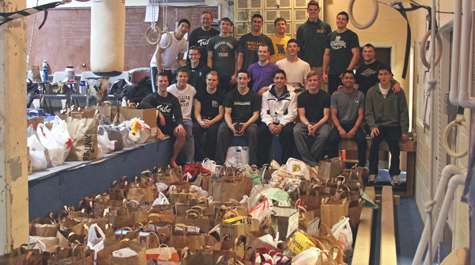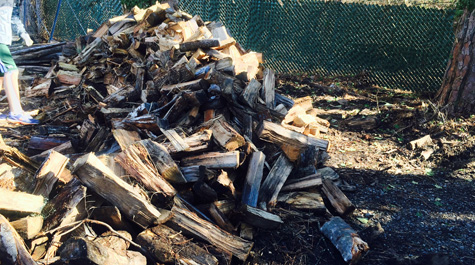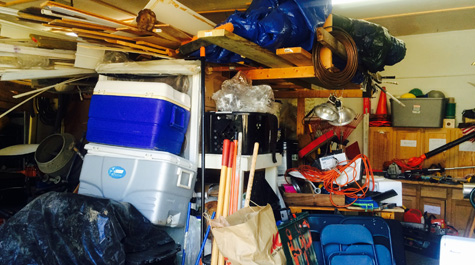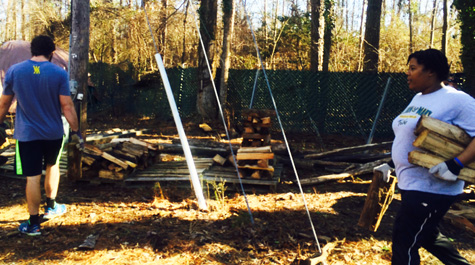Serving more than a tennis term for W&M athletes
William & Mary athletes rang in the new year and new semester the same way they said goodbye to 2014 – by participating in community service projects.
During the holiday break, the men’s gymnastics team continued its traditional food drive to benefit FISH, Inc., an all-volunteer, not-for-profit agency that since 1975 has provided food and clothing to residents in Williamsburg, James City and York counties. The team turned over more than 2,700 pounds of food, its highest total ever.
On the day before the start of the spring semester, football and baseball players worked on emptying and organizing a stuffed-to-the-gills warehouse at Housing Partnerships on Palace Drive. Some track and field members stacked wood for interpreters to use at Jamestown, while other members of the team picked up rakes and shovels and helped beautify the grounds.
Others used this special day of service to travel to local elementary schools for projects that ranged from spending time with children at recess and in class to mulching a garden teachers use in sustainability lessons. In all, more than 200 student-athletes participated.
{{youtube:medium:left|Lr7LBF-30lE, The impact of W&M athletes' service}}
“My parents always told me that helping others is a great way to help yourself,” said Rochelle Evans ’16, a member of the track and field squad. “I love helping people.”
On Jan. 24, the athletic department hosted its second “Gold Rush” basketball game, with the men’s team taking on Northeastern. The goals were to raise awareness for children and adults in the area in need of shoes, and to ease their burden by collecting new shoes. Fans who donated shoes (children or adult) at William & Mary Hall received a free ticket to the game, a free ticket to the Feb. 11 home game against Elon, a coupon for a free Chick-fil-A sandwich and a $10 voucher toward a new C&F Bank checking account.
More than 400 pairs of shoes were collected, exceeding the goal.
Sports Psychology Consultant Deidre Connelly, now in her 23rd year with the university, said that the community service programs athletic teams are involved with began many years ago with the simple act of each sport collecting two food baskets in the fall and the spring for FISH.
The baskets got bigger – they are now laundry baskets, and the football team fills 10 – and the supplies are split between FISH and the Grove Christian Outreach on the other side of town.
Last year, to dovetail with Martin Luther King’s legacy of service, Connelly, in conjunction with the Student-Athlete Advisory Council (SAAC), began setting service projects for the day before classes began.
“We’re trying to educate the student-athletes as they go out,” Connelly said. “We have a concept here at W&M called ‘service-learning.’”
Service learning is a philosophy of activism put forth by the Office of Community Engagement Services (OCES) that stresses four key points: students becoming aware of local needs and diversity, and what they can do to be involved positively; learning responsibility, commitment and the reward of a job well done; gaining perspective on struggling communities and exploring the relevance of a liberal arts education in the world, and developing the skills to engage in world issues.
{{youtube:medium|bvvdULDndbI, W&M athletes at work}}
“Our commitments are short, but we want them to be meaningful experiences in the context of service learning,” Connelly said. “It isn’t just, ‘Let’s go over and rake their leaves,’ then run away. We let the [athletes] know that if they’re at the Housing Partnerships warehouse and they’re moving lumber from here to there, cleaning out things and taking trash to the dumpsters, that helps the next project.
“When the next volunteers come in they can do better work because you have cleared the way for them. What does your service mean? Who might benefit? It’s someone who might not have the means to construct a ramp for their wheelchair. There are people in James City County who don’t have indoor plumbing. We are facilitating those people receiving the assistance they need.”
Here’s a small sample of the projects teams undertook in the fall or are preparing for:
- Women’s volleyball – Seventeen members re-mulched a local elementary school's garden that is used to educate students about nutrition and sustainability.
- Men’s basketball – Five members spoke at a local elementary school about the importance of reading.
- Women’s gymnastics: Sixteen members raised money by walking in the W&M Walks to Prevent Suicide 5k.
- Men’s gymnastics – Nineteen members helped run the Dave Brown Memorial meet for junior Olympic gymnasts.
- Football -- The team plans to hold its annual spring car wash; last year’s benefited the WJCC Head Start program. A dozen or so members also participated in January’s Housing Partnerships garage cleanout.
- Baseball -- Three times the team worked with the ARC of Williamsburg, including baseball-related events involving intellectually disabled adults. The team also raised nearly $6,500 for a foundation that performs cancer research.
- Men’s and women’s swimming – The entire team participated in the James River Swim to raise money for the American Cancer Society.
- Women’s lacrosse – The team listed 11 fall events, including the Beyond Boobs Breast Cancer Walk, in which members set up tables, hung banners and distributed water at local Sanford B. Wanner Stadium.
- Field hockey – Eight members participated in the National Eating Disorder Association's Walk to raise money and awareness for eating disorders.
- Women's cross country/track and field – The program held its annual fundraiser for VCU’s Massey Cancer Center in Richmond, which uses 100 percent of the money for research, funding and aid for families who cannot afford treatment. This year, more than $23,000 was raised.
- Men's golf – The team runs a charity called “Tribe Birdies for Breast Cancer,” that ties charitable donations to the Susan G. Komen Breast Cancer Foundation to the team’s on-course performance.
- Women’s golf – Most members of the team are involved in “Tribe Tutors,” a program that assigns elementary school students an older brother or sister to help them with schoolwork or simply to be their friend“If anything, volunteers typically feel humbled by encountering a new perspective,” she said. “Some people still began the day with a less optimistic outlook; however, after working alongside teammates and with such enthusiastic hosts, I think it is safe to say that everyone saw some type of impact, ranging from happy kids to grateful outreach centers to organized garages."
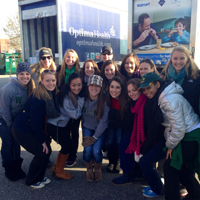 SAAC representative Kelly Okun of women’s golf said the cliché about volunteers getting more from the work they’ve done than the people being served rings true.
SAAC representative Kelly Okun of women’s golf said the cliché about volunteers getting more from the work they’ve done than the people being served rings true.
SAAC representative Brian Waterfield of track and field added that it is easy for students to become immersed in their daily routines and forget the things in life that are important.
“In reality, these experiences help us to gain appreciation for those supporting us and also gain a unique perspective on what it means to help others,” he said. “Everyone involved in these service projects left satisfied, not only because it allowed us to bond as a team but because we saw the immediate impact we left on those organizations.”
Connelly said there are three questions that she asks all of the volunteer athletes to ponder when they return to campus.
“What? So what? Now what?” she said. “What did you accomplish today? What impact did it have? What will you do next?
“We tell them, ‘If you’re at a school, you don’t know the students’ background. You might have made some child’s day just by being a cool older person who paid attention to them – and maybe you taught them something in the art lab. You just never know.”














